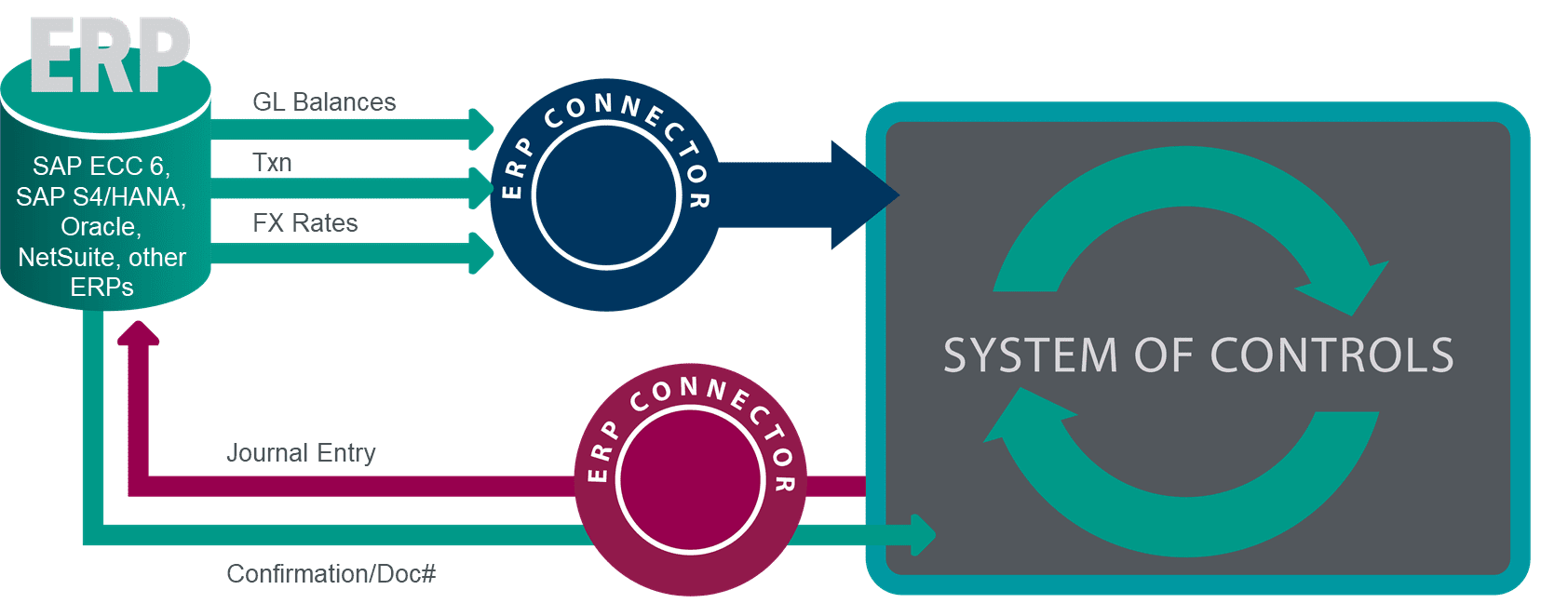System of Integration: ERP Connectors
Blog post
Share
 Organizations have naturally built up their internal financial application ecosystem through acquisition and sheer necessity. While well intentioned, this means we end up with a slew of disparate internal applications all leaning on the thin internal IT team with a 6-month lead time before they can even consider new requirements for integration with the system of record. Our ability to monitor risk and make the most effective decisions is also hindered with controls occurring in other applications and environmental silos.
Organizations have naturally built up their internal financial application ecosystem through acquisition and sheer necessity. While well intentioned, this means we end up with a slew of disparate internal applications all leaning on the thin internal IT team with a 6-month lead time before they can even consider new requirements for integration with the system of record. Our ability to monitor risk and make the most effective decisions is also hindered with controls occurring in other applications and environmental silos.
What is needed to transform and revolutionize the office of finance is an enterprise system of controls that enables an efficient close with accurate and reliable reporting. This system of controls needs to work closely with your financial system of record, for example, your ERP system, to enable financial controls and Record to Report (R2R) activities such as transaction account matching, GL reconciliations, close tasks, journal entries, or even compliance testing while extending into your office of finance’s ecosystem for controls in treasury, tax, reporting and more.
Our System of Integration: ERP Connectors enable these key integrations while strengthening and extending this capability over time. Trintech’s ERP Connectors (SAP®, NetSuite®, Oracle®, Universal ERP*) are the key to enabling you to view, match, reconcile and manage GL balances/transactions, then validate and post period-end or adjusting journals in a unified R2R user experience. These Connectors provide real-time integration and visibility, improve efficiency and allow your business and IT teams to work on higher priority items than data exchange.

As a foundational element, Trintech’s ERP Connectors support all ERPs. This includes SAP 4.7, SAP ECC6, SAP S4/HANA, Oracle, NetSuite, QuickBooks – and yes – even mainframe systems. Our ERP Connectors are designed to leverage direct ERP integration options when available (ABAP Code, API, etc.) as certified ERP-specific integrations. Where they are not available, Trintech provides a universal connection option to ensure no source data is unattainable. Our deep subject matter experts have spent years honing their skills and are also able to offer their expertise and best practices for streamlined connectivity.
So, where should you start? You may be surprised at the depth of knowledge and level of effort needed to build and maintain a relatively straight forward extract. You are not alone! Customers of all sizes struggle with creating and maintaining an interface that continues to help meet their business objectives. Below are a few examples of integrations we’ve built out to help our customers support their core business:
- GL Balances and Transactions
- ERP-specific versions such as SAP new GL transaction, SAP classic GL transactions or SAP special purpose ledgers
- Note: SAP special purpose ledger is often customized in each ERP, and we can additionally support those customer needs
- ERP-specific versions such as SAP new GL transaction, SAP classic GL transactions or SAP special purpose ledgers
- FX Rates
- Intercompany, AR/AP
- Fixed Assets
- Inventory
- Customer-defined frequency
- Full refresh
- Incremental refreshes (important for larger data sets)
- Open Item Clearing
- Journal Entry Validation, Posting and Roll-back
- Managing posting from one Journal Entry to multiple ERPs simultaneously
- Download and go from SAP App Center, NetSuite App Center, SAP Fiori Pane
Trintech’s universal connector strategy enables us to partner with our customers for quick data integration, regardless of structure, driving validation, conversion, transformation and integration – all within a matter of minutes. In future posts, we will discuss how we can also extend these integrations with ERP Bots to automate complex activities inside your ERPs to maximize ROI and reduce costs – for example tax rate lookup and calculations, subledger postings such as intercompany AP/AR ledgers and triggering the production of invoices in the ERP that result from these entries.
As you can see, ERP Connectors, and an ERP connectivity strategy are a key part of how we enable your system of controls in partnership with your system of record (ERP). Others in the market may try to add new systems of records as they help you close, but that only adds cost, risk and complexity to your world and confusion when systems used to validate become source records. Our system of controls will improve your close and reduce your risk while leveraging our Record to Report Automation Framework to reduce your costs.
Check out our next blog as we uncover Trintech’s System of Integration – APIs.
Written by: Michael Ross, Chief Product Officer at Trintech
Explore the Full 8-Part Series on Trintech’s Record to Report Automation Framework
Part 1 – How a System of Controls Can Move Your Financial Reporting from Flipping a Coin to a Sure Investment
Part 2 – How to Improve Controls, Reduce Risk and Lower Costs with a Record to Report Automation Framework
Part 4 – R2R Automation Framework: APIs
Part 5 – R2R Automation Framework: 3rd Party RPA Connectors
Part 6 – R2R Automation Framework: ERP Bots
Part 7 – R2R Automation Framework: Risk Intelligent RPA
Part 8 – R2R Automation Framework: Artificial Intelligence
Additional Resources:






